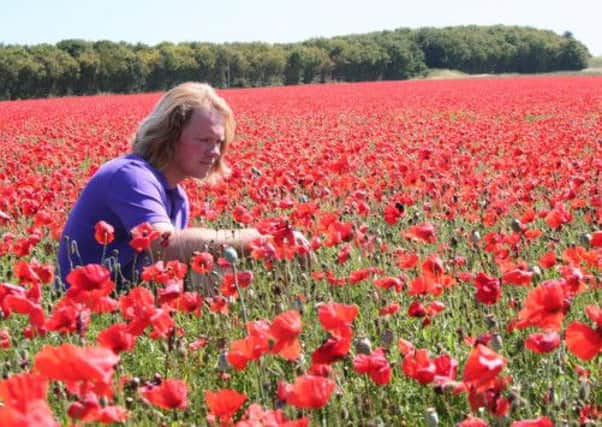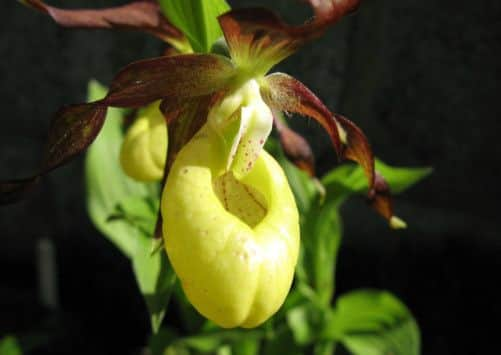Chris takes a walk on the wild side as new nature star in the TV landscape


When we arrange to speak, Chris Myers warns the mobile signal will very likely be a little erratic.
It’s par for the course. The Skipton garden designer is the epitome of the outdoors type and has always resisted any job which would involve him being stuck behind a desk for too long. When he’s not out and about advising clients how to make the best of their gardens, he’s usually found fell walking in some remote spot or snatching a little quiet time fishing on the side of a river.
Advertisement
Hide AdAdvertisement
Hide Ad“I’m one of those sorts who needs a fresh air fix every day and I’d usually much rather be out walking in the lanes, striding the hills or mucking about on my in-laws’ farm than being cooped up indoors. Cities have their limits for me and it’s not long before I’m dying to be back home again where I can soak up my surroundings.


“I grew up round here and feel really lucky to have seen the seasons change and to have experienced that very subtle beat of the natural calendar from an early age.”
It was Chris’s ability to wax lyrical about the beauty of Britain’s natural landscape that caught the eye of a TV producer looking to film a new nature series for Channel 4. The idea of Wild Things was to unlock the mystery behind Britain’s changing landscape over the last 50 years with Chris joining leading botanist Dr Trevor Dines and lichenologist Sally Eaton.
It’s now midway through the series, but Chris, who trained in garden design at Askham Bryan college in the early 1990s, says it has been as much an education for him as he hopes it will be for the viewers.
Advertisement
Hide AdAdvertisement
Hide Ad“The last year or so has definitely been a bit of a learning curve,” he says. “I never had ambition to be on television, but what an opportunity. I’ll never forget the day I got the call asking if I would be interested in becoming a presenter. I honestly thought someone was winding me up. The next thing I knew I was in the middle of a field near Bolton Abbey talking to camera at some length about the qualities of the humble nettle. I didn’t realise it at the time, but that was my screen test and apparently I passed.”
While Chris already knew pretty much every corner of the Dales and North Yorkshire had been his playground every since he was a small child, he says working on the programme has made him see the landscape in a new light.
“It’s like anything you see every day, you tend not to notice the changes,” he says. “I’ve always viewed going out for a walk as a bit of a treasure hunt. I like to know what’s living in every crevice and every corner. When I don’t know what I’ve found I go home and look it up, that’s just the way I’m built. However, I guess what doing the programme confirmed was just how changeable mother nature can be.
“We are lucky in Yorkshire in that we still have that patchwork of small fields which in many other parts of the country have disappeared, but we can’t be complacent because if the pace of change of the last 50 years continues for another half century then we really will be living in a very different landscape.”
Advertisement
Hide AdAdvertisement
Hide AdSome of the changes are just part of the natural cycle of things, but the modern world has left its mark on Yorkshire and the rest of the country.
Increased levels of nitrogen released into the air from car exhausts, industry and agriculture have altered the chemical make-up of soil. While this fertiliser rain has caused some species of plants like nettles to thrive, it has strangled some smaller, more delicate species.
Elsewhere changing agricultural processes have hastened the decline of traditional wildlife habitats from wetlands to grasslands, which has had a knock-on effect on biodiversity.
“Farming has a huge influence on the landscape, it always has and it always will,” says Chris.
Advertisement
Hide AdAdvertisement
Hide Ad“We can’t expect the industry to remain how it was 100 years ago, the changes of the last 50 years have been rapid. Until the mid 20th-century, many farms were mixed and combined livestock with the growing of cereals and each farm also maintained some grassy pasture for grazing. As they rotated the crops and fields it led to a real diversity of plant species, but modern farms are very different beasts.
“They tend to concentrate on either livestock or cereals and in this part of the world it tends to be the former and as a result plant diversity has declined. It’s not necessarily a criticism – farmers not only have to make ends meet and they have to feed a growing population – but it is a fact of life.
“It doesn’t stop the countryside being beautiful. The Yorkshire moors are in effect a managed landscape and I defy anyone not to be left speechless when the heather is out in all its purple vibrancy.
“The whole point of our research was not to point fingers or apportion blame, but rather to do a spot check on where the landscape is now so we can have something to compare it to in the future.”
Advertisement
Hide AdAdvertisement
Hide AdThe country has also witnessed a spread of non-native plants and while many escaped species, such as pineappleweed, are benign and have added colour to the landscape, others like rhododendron, Spanish bluebell and New Zealand pigmyweed all have the potential to upset nature’s delicate balance.
“I know a lot about plants, but for a long, long time I just assumed rhododendron was a native species,” says Chris. “It’s a feature of so many historic gardens, but when you see how it has spread across somewhere like Snowdonia it really brings into sharp focus how rampant certain species can be. In those kind of scenarios it’s inevitable that more fragile flowers and plants end up being squeezed out.
“The figures are quite startling. One in five of our forest flowers are now under threat and even quite common plants like wood anemone are disappearing.”
It’s also impossible to get away from climate change. With growing seasons now longer and hotter and winters both milder and wetter, plants are not only responding by flowering earlier, but by appearing in new parts of the British Isles. In 1962, a species like hart’s tongue fern was concentrated in the south of the country, but over the last 50 years it has moved north and now is found in pretty much all of Yorkshire.
Advertisement
Hide AdAdvertisement
Hide Ad“The last year has been one long, cross country trail of discovery and the truth is even the idea of conservation is constantly evolving. In the past, rare plants were often fenced off, but those kind of defensive tactics often only served to isolate species.
“We now know that those kind of defensive tactics don’t work and it’s not about wrapping plants in cotton wool. However, if I had one wish it would be that we could leave at least a little of our landscape to nature and allow the bees, butterflies and plants to do what they do best.”
Wild Things is on Channel 4 on Mondays at 8.30pm. A book to accompany the series, priced £20, is out now. To order through the Yorkshire Post Bookshop call 01748 821122.
How Yorkshire’s endangered Lady’s-slipper orchid got back on the right foot
Advertisement
Hide AdAdvertisement
Hide AdOn a remote hillside in Yorkshire, there’s a plant which is almost the last of its kind.
Lady’s-slipper orchid was once found in various parts of the country, including Derbyshire, Cumbria and County Durham where it grew on steep slopes of wildflower-rich limestone sheltered by open woodland.
Described as Britain’s most flamboyant native orchid it looked as though it should be growing in the tropics rather in the much more temperate British Isles.
However, the plant with a bright yellow pouch and deep burgundy leaves paid a heavy price for its good looks. During the 18th-century bunches of lady’s-slipper orchid were supplied to hotels and whole clumps were dug up from the wild and sold to private gardeners.
Advertisement
Hide AdAdvertisement
Hide AdBy 1917, the orchid was declared extinct in the British Isles. However, in 1930, a single last surviving plant was found on a wooded hillside in the Yorkshire Dales. It’s location was kept secret and to prevent theft, during its flowering period the site was kept under 24-hour surveillance, with trip wires and CCTV occasionally employed. In 1989 a re-introduction programme was launched and since then the number of sites where the orchid grows has risen from one to eight. The lady’s-slipper is not out of the woods yet, but in 2011, 127 flowers were recorded and it is now possible to see the orchid in the wild at Kilnsey Park and also at the Gait Barrows reserve in Lancashire.